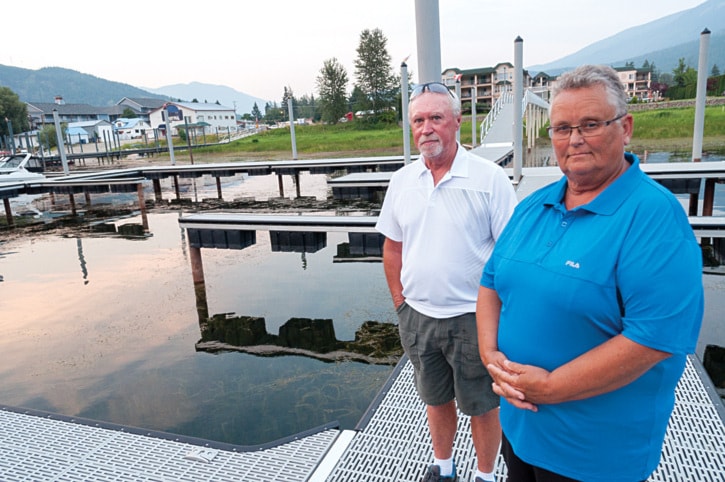Unless the Sicamous channel is dredged, the community may see some of its tourism economy slip away.
This was part of the message delivered to District of Sicamous council by Mary-Ann Easton and Bill Anderson, who served as a delegation representing stratas for the Riverside and the Narrows.
With the low water in the channel, marinas for the two condominium complexes have seen their number of usable boat slips reduced by 57, while a total of 173 boat slips throughout the channel, including those in business and residential marinas, are now unusable.
As Easton explained, the reduction in usable slips is a result of a low snow pack, little rainfall and the subsequent rapid drop in water levels as of late throughout the Shuswap.
Exacerbating the matter for Easton and other Riverside owners is the fact their marina’s dock is constructed to current federal government standards, requiring a 1.5 metre water depth (at low water) beneath. As a result, half the moorage at Riverside is now suspended about three feet above the water.
Anderson said the foreshore lease for the Narrows is coming up for renewal in about three years and residents there are concerned they could find themselves in an even worse situation regarding the availability of usable slips, if and when their dock is reconstructed to today’s standards.
But neither Easton nor Anderson were upset with the standards, designed to protect fish habitat. Instead, they are focused on getting the channel dredged, which they say could locate all the slips in water greater than the 1.5 metres, benefitting boaters, fish habitat and the local economy in general.
Anderson noted that fish are nowhere to be seen around the docks and shoreline in the channel as the temperature at the shallow depths is uninhabitable.
“The other factors considered is that with the increasing sediment, milfoil and grasses in the channel. It decreases the flow and heightens the potential for flooding issues as seen in 2012,” said Anderson. “With the yearly expansion of sediment and grasses, it only contributes to our shoreline narrowing and more.”
It could be said Easton and Anderson were preaching to the converted. Prior to their delegation, council had discussed the need for dredging, and asked staff to come back with a report on the possible options.
Coun. Todd Kyllo provided some background, noting a study on dredging options completed in 2003, paid for in part by businesses and stratas on the channel, shows how dredging would make the channel better for fish.
“Basically, what’s happening is the channel is silted in with a black sediment which, when the sun shines on it – it’s like tinfoil underneath the water… It heats the water up too high so fry don’t even want to go there,” said Kyllo, adding the study also showed notably higher numbers of fish were found in areas where dredging last occurred.
“So basically, the study… showed it could be more environmentally friendly for the fish, and it would create the economic setting that drives the channel today, and yet DFO (Fisheries and Oceans Canada) is still sitting on it.”
Coun. Jeff Mallmes confirmed that while the provincial government has long been amenable to dredging, the federal government, particularly Fisheries and Oceans, has been reluctant to support dredging, placing priority on the protection of fish habitat. However, Mallmes said he’s been in discussion with consultant Barry Penner, B.C.’s former environment minister who was influential in getting approval for a dredging project in the lower Fraser River. Mallmes said Penner’s services could cost the district up to $30,000, but the end result might be worth the investment.
“Thirty grand could get it to the point where maybe it could be dredged. It’s a tough road that one,” said Mallmes, who later advised Easton and Anderson that a community effort may be needed to get the federal government onboard.
“I think if we put this forward to them and if we put up a good fight we might have a chance,” said Mallmes.
